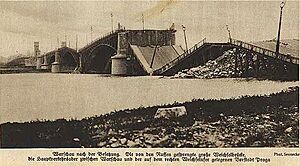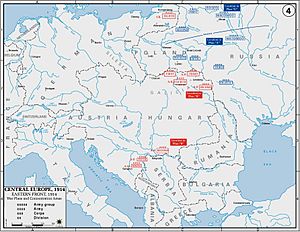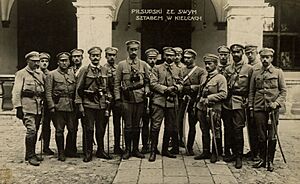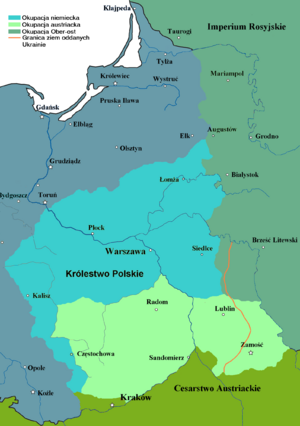History of Poland during World War I facts for kids
| Part of World War I | |
 |
|
| Duration | 1914-1918 |
|---|---|
| Motive | The expansionary policy of the occupying powers. |
| Participants | Russian Empire, German Empire, Austro-Hungarian Empire |
| Outcome | 1,400,000 Poles conscripted into the Austro-Hungarian army 1,200,000 Poles conscripted into the Russian army 700,000 Poles conscripted into the German army Collapse of all three occupying Empires Establishment of the Second Polish Republic. |
| Deaths | 450,000-600,000 military deaths 1,128,000 deaths overall |
| Property damage | Destruction of over 1,800,000 buildings and half of the bridges Production output fell to 20% of its level before the war Polish industry suffered the loss of an estimated 73 billion French francs. |
During World War I (1914-1918), Poland was not an independent country. Instead, its land was divided among three powerful empires: the Russian Empire, the German Empire, and Austria-Hungary. Because of this, Poland became a major battlefield on the Eastern Front.
Many battles took place on Polish soil, causing huge losses of life and property. After the war, all three empires collapsed. This allowed Poland to become an independent nation again, known as the Second Polish Republic.
Contents
How Poland Was Divided Before WWI
Before World War I, Poland had been split up in a series of events called the partitions. Its lands were controlled by Russia, Germany, and Austria-Hungary. When the war began, these three empires found themselves on different sides. Russia joined Britain and France against Germany and Austria-Hungary, who were part of the Central Powers.
This situation meant that Polish lands became a key battleground. Soldiers from all three empires fought fiercely across the country.
Empires' Different Goals for Poland
The war created a chance for Poles to gain some power. Both sides, the Central Powers and the Allies, promised Poles more freedom if they supported them and joined their armies.
Austria-Hungary wanted to add the Russian part of Poland, called Privislinsky Krai, to its own territory, Galicia. Because of this, they allowed Polish nationalist groups to form before the war.
Russia also recognized that Poles should have some self-rule. They allowed the Polish National Committee to form, which supported Russia. Russia's foreign minister even suggested creating an independent Kingdom of Poland. This new kingdom would have its own government and use the Polish language in schools.
As the war continued and became a long, difficult fight, the idea of Polish self-rule became more urgent. Roman Dmowski, a Polish leader, worked in Western Europe. He hoped to convince the Allies to unite all Polish lands under Russian rule first, as a step towards full independence.
Józef Piłsudski's Vision
Józef Piłsudski, another important Polish leader, believed that the war would weaken all three empires controlling Poland. He thought this would be Poland's chance to become free. So, he formed the Polish Legions to help the Central Powers fight Russia. This was his first step towards Poland's independence.
Piłsudski secretly spoke with the Western Powers. He promised them that his soldiers would only fight against the Russians, not against Britain or France.
Polish Feelings Towards Invading Armies
When German forces entered Poland, Poles did not see them as liberators. Instead, they felt distrust and hostility. This was different from how they had felt about Napoleon's forces a century earlier.
Many Poles felt sad and uncertain when Russian soldiers retreated. There was no harassment of Russian soldiers. This was because Russia had become more liberal after the 1905 Revolution. In contrast, Germany had tried to make Poles within its borders more German. This included events like the Września school strike and the Destruction of Kalisz in 1914. These actions made Poles feel more pro-Russian and anti-German.
However, this changed in late 1915. Russia began to take resources from Polish lands, which made Poles less sympathetic towards them.
The people who suffered the most during the war were the Poles. Most of Poland west of Warsaw became a battlefield. Large areas were destroyed by the Germans as they retreated. Poles were treated poorly by all sides. They had to endure a harsh winter in their damaged towns and villages, hoping for a better future.
Kingdom of Poland (1916–1918)
In 1916, Germany and Austria-Hungary tried to get more Polish support. They announced that a new state, the Kingdom of Poland, would be created. This new kingdom was actually a puppet government. This meant it would be controlled by Germany in terms of military, economy, and politics.
The new kingdom would only be a small part of the old Polish lands. Germany also planned to take about 30,000 square kilometers of western Polish territory. They wanted to remove Polish and Jewish people from these areas and replace them with German settlers.
A Regency Council was set up to prepare for this new state. It acted as a temporary government and even issued its own money, called the Polish mark. However, Germany's efforts to create a Polish army to fight for the Central Powers failed. Not enough Poles volunteered for their cause.
After the Treaty of Brest-Litovsk ended the war in the East, Germany and Austria-Hungary continued their plan to create a "Mitteleuropa" (Central Europe). On November 5, 1917, they officially declared that a Kingdom of Poland would be created.
Poland as a Battlefield

Much of the intense fighting on the Eastern Front happened in Poland. In 1914, Russian forces advanced close to Kraków before being pushed back. The next spring, heavy battles took place around Gorlice and Przemyśl in Galicia.
In 1915, the retreating Imperial Russian army looted and abandoned Polish territories. They used a "scorched earth" tactic, similar to 1812, destroying everything useful. The Russians also forced hundreds of thousands of people to leave their homes, suspecting them of helping the enemy. By the end of 1915, the Germans had taken control of all the Russian-held areas, including Warsaw.
In 1916, another Russian attack in Galicia, called the Brusilov Offensive, made life even harder for civilians. About 1 million Polish refugees fled eastward behind Russian lines during the war. Even though the Russian attack surprised the Germans and Austrians, poor communication stopped the Russians from fully winning.
Human and Material Losses
About 450,000 Poles died and around 1 million were wounded while fighting in the armies of Austria, Russia, and Germany. By 1916, nearly 2 million Polish soldiers were fighting in these armies.
Hundreds of thousands of Polish civilians were sent to labor camps in Germany. An estimated 800,000 were forced to leave Congress Poland by the Russians and sent to the East. The "scorched-earth" tactics used by both sides made many war zones unlivable.
The total number of deaths from 1914 to 1918, including both soldiers and civilians, was estimated at 1,128,000. Around 1,800,000 buildings and half of the bridges in Poland were destroyed. The country's production of goods dropped to only 20% of what it was before the war. Polish industries lost an estimated 73 billion French francs.
A British relief director described the situation: "The country...had undergone four or five occupations by different armies, each of which had combed the land for supplies. Most of the villages had been burnt down by the Russians and their retreat (of 1915); land had been uncultivated for four years and had been cleared of cattle, grain, horses and agricultural machinery by both Germans and Bolsheviks. The population here was living upon roots, grass, acorns and heather. The only bread obtainable was composed of those ingredients, with perhaps about 5 per cent of rye flour..."
The lack of food led to widespread hunger and sickness. This, combined with diseases brought by soldiers returning from the front, greatly increased the death rate among the local people. Many areas in eastern Poland suffered from famine.
Polish Soldiers in Different Armies
During World War I, many Poles fought in the armies of the countries that controlled their land. They also formed their own units, hoping to fight for Poland's freedom.
- German Empire: Many Polish soldiers served in various German divisions, including the 10th, 35th, 119th, 121st, 214th, 235th Infantry Divisions, and several Reserve Divisions.
- Austria-Hungary: Polish Legions, like the I, II, and III Brigades, were formed. There were also several Uhlan (cavalry) Regiments with many Polish soldiers.
- French Third Republic (Blue Army): After the Armistice, Polish Rifle Divisions (1st, 2nd, 3rd, 6th, 7th) were formed to fight alongside the French.
- Russian Empire: Polish I Corps and Polish II Corps in Russia included Polish Rifle Divisions (1st, 2nd, 3rd, 4th, 5th).
Poland Becomes Independent Again
In 1917, two major events changed the war and led to Poland's rebirth. The United States joined the Allies. At the same time, the Russian Revolution weakened Russia and eventually removed them from the Eastern Front. Russia was forced to sign the Treaty of Brest-Litovsk, giving up all former Polish lands to the Central Powers.
With Russia out of the war, American President Woodrow Wilson called for the war to be a fight for democracy and freedom. His "Fourteen Points" included the idea that Poland should become an independent nation again. This made Poles strongly support the Allied cause.
Józef Piłsudski became a national hero when he was jailed by Berlin for not obeying orders. By autumn 1918, the Allies had broken the Central Powers' resistance. The Austro-Hungarian Empire fell apart, and the German government collapsed.
In October 1918, Polish authorities took control of Galicia and Cieszyn Silesia. In November 1918, Piłsudski was released from Germany and returned to Warsaw. On November 11, 1918, the temporary government, the Regency Council, gave all its power to Piłsudski. He became the provisional Chief of State of the newly formed country. Soon, all local governments pledged loyalty to the central government in Warsaw. After 123 years, independent Poland was reborn!
The new state initially included the former Privislinsky Krai, western Galicia (even though Lwów was under siege by Ukrainians), and part of Cieszyn Silesia.
See also
- History of Poland (1795–1918)
- History of Poland (1918–1939)
- Diplomatic history of World War I
- Kingdom of Poland (1917–1918)





